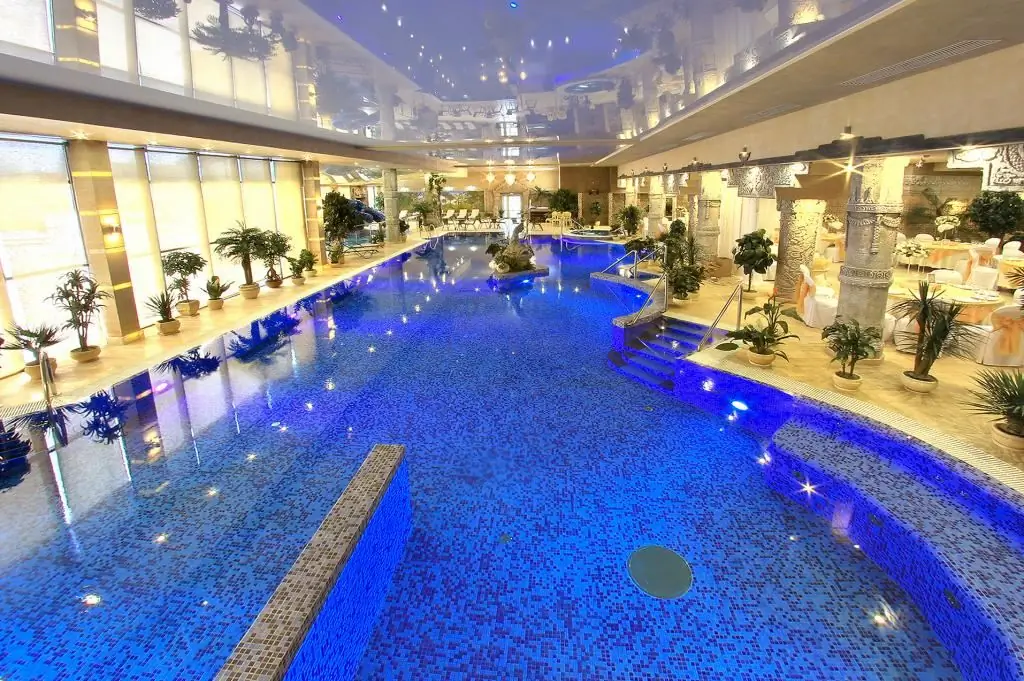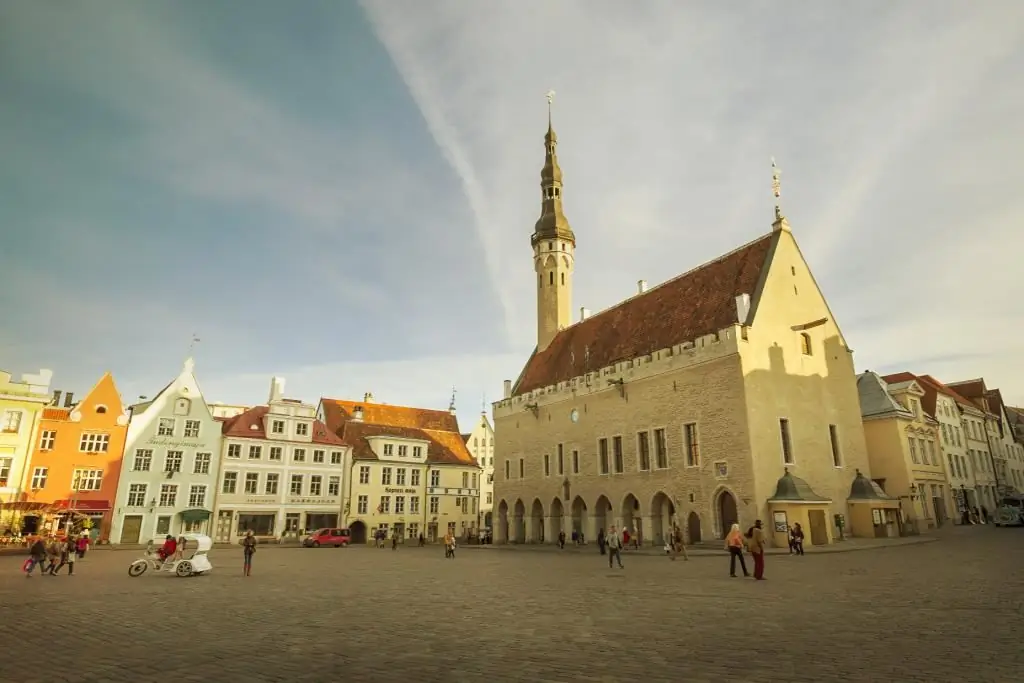- Author Harold Hamphrey [email protected].
- Public 2023-12-17 10:06.
- Last modified 2025-01-24 11:10.
Narva Castle causes historians to argue, as they cannot agree on the exact date of its creation. However, there are facts that allow specialists to determine the chronology of the development of the city and this stone structure. One thing is clear - the approximate time of the birth of Hermanni linnus (Est.) falls on the end of the Middle Ages. So, Narva Castle: history of occurrence, opening hours, address and reviews of tourists.
Castle location
This defensive structure is located in the Estonian city of the same name on the banks of the Narva River! And no confusion, pretty easy to remember. But you also need to know that it is also called Herman's Castle. To make it easier to understand the location, just look at the map: it shows that the opposite bank belongs to Russia, there is the Ivangorod fortress, also built to strengthen the borders by decree of Ivan III in 1492.

Narva Castle: history of origin
Initially, a wooden fortress was erected on this site, crossing the old road and the river. Its construction dates back to the 13th century, when the Danesconquered Northern Estonia. Later, under the cover of this castle, the city of the same name also developed. When conflict situations with the Russians began to occur on the opposite bank of the river, the Danes seriously thought about the need to create a stronger defense. To this end, already in the XIV century, the construction of a stone fortress began, which was a building with walls and towers about 40 m high. The modern Narva Castle is a follower of this particular structure.
From the beginning to the middle of the 1300s, the outer courtyard was completed: at first it was small, then it became larger. In this place, local residents were supposed to hide in the event of a war. But already in 1347, the Danish king sold Northern Estonia, along with Narva, to the Livonian Order. From now on, the castle serves as the home of the convention. By the way, part of the first level of the building, the courtyard and the halls have been preserved in their original form to this day.
During the possession of the fortress by the Livonian Order, the Herman Tower was built. We can say that this action was a response to the Russians, who built a fortress on their (opposite) bank - Ivangorod. Narva was also "hidden" in its arms by a wall that has not survived to this day - it was demolished in 1777. There are records indicating that four gates with iron plates and a drawbridge were built into it. The length of the wall was approximately 1 km and was surrounded by a moat, and 7 towers were built as additional protection. Later, the order fortified the gates and built cannon towers (one of them survives). But this did not help - in 1558 the Russiansafter all, they recaptured the city.
Thirty years later, Narva was captured by the Swedes. The Russians lost after the first battle, and since 1700 the fortress belongs to Sweden. And again, construction is in full swing here: the Wrangel bastion appears, the Dark Gate is being completely reconstructed, and positions for cannons on the fortifications are being set up.
The Swedes did not have long to rejoice in the acquisition, because 4 years later Peter I returns this territory and the Narva Castle (photo below) - the fortress again belongs to the Russian Empire. The shelling of the facades of the bastions lasted 10 days, after which two of them collapsed. So the Russians took the city for the second time, along with all of Estonia.
But after such events, Narva lost its strategic importance, although the fortress was considered an external fortification of St. Petersburg for about 150 years. The bastions were restored, and the construction of the ravelins begun by the Swedes was completed. In 1863, Narva lost the status of a fortress city, on the territory of one of the bastions called Victoria, a park was created, named after the main gate Dark Garden. The gates were finally destroyed in 1875.
Narva Castle was almost completely destroyed in 1944. The Second World War was literally a fatal event for him, as Soviet aviation destroyed most of the structures to pieces. From 1950 to the present day, the reconstruction of the fortress is slowly but surely going on. But the main thing is that the castle has retained its medieval appearance, despite the trials that fate has prepared for it.

Castle in the 21st century
Today, this austere and slightly gloomy stone structure houses the Narva Museum and craftsmen's workshops. Visitors to Estonia and local residents are told about the history of the city and about what events the fortress went through, starting from the 1500s. Exhibition halls are equipped in the tower called Long German. Sometimes concerts are held here. This fortress in the 21st century is a place where festivals, celebrations and other fun events are constantly held.

Where is the fortress and how to get to it?
The Narva castle is located on the Petersburg highway in the city of Narva. Nearby is the Russian-Estonian border. Thanks to this location, it is easy to find Narva Castle. Address (exact): Estonia, Narva, Petrovsky square, 2. Phone: +3723599230.

Castle opening hours and ticket price
A visit to the fortress will turn into an interesting journey into the past, despite the season. Everyone, choosing a convenient time for himself, can visit the Narva Castle. Opening hours: Wednesday to Saturday from 10 am to 6 pm. You can enter the territory of the fortress for free, and if you want to go inside to see the interior of the halls, which was recently restored, you will have to pay an average of 4 euros.

Interesting facts
- In the 16th century, when Narva belonged to the Russian Empire, it was the only Russiantrading port in the B altic.
- When the construction of the Ivangorod fortress began on the opposite bank, the inhabitants of Narva experienced "great inconvenience": the Russians constrained them in fishing and trade, and also shot at inopportune hours. By the way, the Estonian side did not lag behind in the latter.
- The battle for Narva, which took place in 1700, was significant for Russia. This is the first battle of the Russian regular army in history.

Narva Castle: reviews of tourists
It is not for nothing that this fortress is one of the main attractions of Estonia, because all the battles of different peoples for this small state in one way or another concern it.
First of all, I would like to note that now it is very beautiful there. Somehow, this area perfectly combines the severity of the Middle Ages with some elegance.
Secondly, visiting the fortress is the best opportunity to immerse yourself in the life of the Middle Ages, find out how people lived, and introduce children to the history. By contacting the property, you can find out when festivals, fairs and other interesting events take place in the territory in order to take part in them.
Tourists who have visited this place claim that Narva Castle is the embodiment of an entire era. Both outside and inside, the fortress is of interest and fascinates. Particularly impressive is the view of the Ivangorod fortress, which is connected to Narva by a bridge. Therefore, visiting the castle will be an educational and exciting experience for adults and children!






